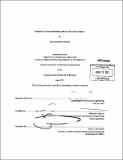Mechanics of jammed media used as a structural element
Author(s)
Khalifa, Sammy Mohsen
DownloadFull printable version (1.842Mb)
Other Contributors
Massachusetts Institute of Technology. Dept. of Mechanical Engineering.
Advisor
Alexander Slocum.
Terms of use
Metadata
Show full item recordAbstract
Granular medias such as sands, beads and even coffee exhibit the phenomenon of jamming when exposed to compressive stresses. Jamming refers to the process by which a normally smooth flowing material comprised of discrete individual grains forms a pseudo-solid when subjected to stress. Under normal loading, the interactions between individual particles of the material are not great enough to severely inhibit relative motion but when the macroscopic material is subjected to a large compressive force, the interlocking of and friction between the individual granular particles takes over and forms an interlocked, solid like structure. The extent to which a media jams is dependent upon many properties of the media including the size, shape, homogeneity, surface texture and chemical makeup of the particles. It is also dependent upon the magnitude of the force applied to the media and the distribution of the force applied. Using vacuum to apply stress, jammed media can be used to create easily reconfigurable structural elements. The analysis of such a structural element is very similar to analyses done in soil mechanics where the "strength" of the soil depends on the stress applied, the rate of stress application and the physical properties of the soil particles themselves. Most applications of soil mechanics (such as with buildings or vehicles) are concerned with the interaction of the force at what could relatively be considered the surface of the soil due to the much greater diameter of Earth. A jammed media structure is of finite thickness and thus loads can easily permeate through the entire structure. Thus to properly understand the mechanics under which jamming can occur a simple model was created. This model looks into the behavior of jammed structures subjected to three point bending. It does so by examining the forces between the individual particles and using simple beam bending mechanics. A downward trend was observed in the strength of a jammed structure relative to the grain size of the granular media. This trend was corroborated by a physical test of beams on an Instron machine.
Description
Thesis (S.B.)--Massachusetts Institute of Technology, Dept. of Mechanical Engineering, 2012. Cataloged from PDF version of thesis. Includes bibliographical references (p. 22).
Date issued
2012Department
Massachusetts Institute of Technology. Department of Mechanical EngineeringPublisher
Massachusetts Institute of Technology
Keywords
Mechanical Engineering.